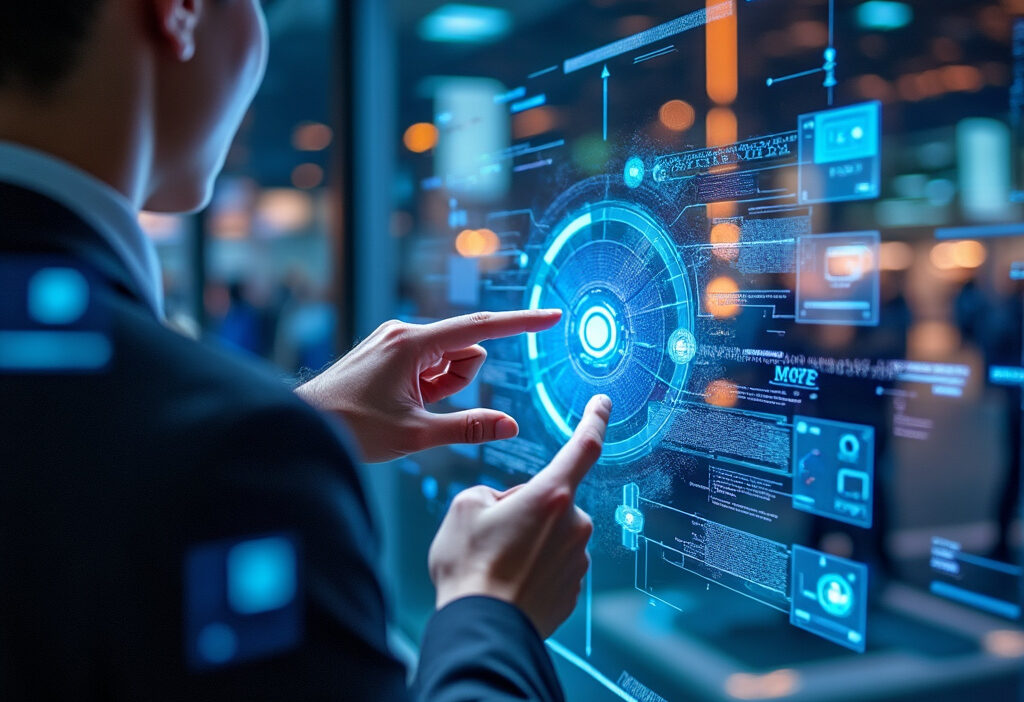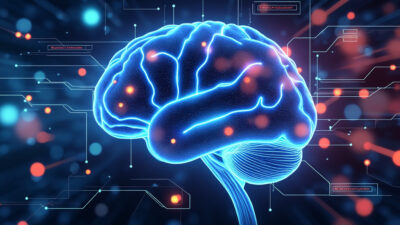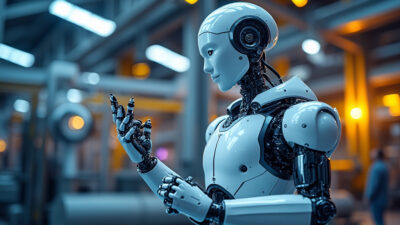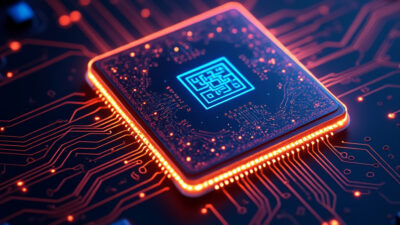Spatial Computing Blurring the Lines Between Physical and Digital Realities
Spatial computing represents a groundbreaking shift in how we interact with technology, merging the physical and digital worlds into a seamless experience. This article delves into the essence of spatial computing, its evolution, and its transformative potential across various sectors. From augmented reality to natural user interfaces, we explore how this technology is redefining human-computer interaction.
The Foundations of Spatial Computing
Spatial computing represents the next evolutionary step in how humans interact with digital environments, merging the physical and virtual worlds into a cohesive experience. Its foundations trace back to early geographic information systems (GIS), which mapped spatial data in two and three dimensions, laying the groundwork for understanding how digital representations could mirror real-world spaces. The 1960s and 70s saw pioneering virtual reality (VR) experiments, such as Ivan Sutherland’s “Sword of Damocles”, which introduced head-mounted displays and primitive spatial tracking—concepts that remain central to spatial computing today.
Key to spatial computing’s development are sensor technologies, which enable devices to perceive and interpret the physical environment. LiDAR, depth sensors, and inertial measurement units (IMUs) provide precise spatial awareness, while computer vision algorithms process visual data to identify objects, surfaces, and movements. These technologies allow digital content to anchor itself realistically within physical space, responding dynamically to user interactions.
Early VR systems relied on bulky, expensive hardware, but advancements in miniaturization and processing power have democratized spatial computing. Modern implementations leverage simultaneous localization and mapping (SLAM), enabling devices like AR glasses and smartphones to understand their position in 3D space without external markers. The integration of haptic feedback and spatial audio further enhances immersion, making digital interactions feel tangible.
The convergence of these foundational technologies has transformed spatial computing from a niche research field into a practical tool reshaping industries like architecture, healthcare, and entertainment. By blending digital precision with physical intuition, spatial computing bridges the gap between human perception and machine intelligence, setting the stage for even deeper integration in the future.
Understanding the Technologies Behind Spatial Computing
Spatial computing relies on a suite of advanced technologies that seamlessly blend digital content with the physical world, creating immersive and interactive experiences. At its core are augmented reality (AR), mixed reality (MR), and natural user interfaces (NUIs), each playing a critical role in shaping how users perceive and engage with three-dimensional spaces.
AR overlays digital information onto the real world, enhancing perception without fully replacing it. This is achieved through devices like smartphones or AR glasses, which use cameras and sensors to map the environment and anchor virtual objects in real space. MR goes a step further by allowing digital and physical elements to interact dynamically. For example, a virtual ball in MR can bounce off a real table, requiring precise spatial mapping and real-time processing.
NUIs enable intuitive interactions by interpreting human gestures, voice, and gaze as input. Unlike traditional interfaces, NUIs eliminate the need for keyboards or touchscreens, allowing users to manipulate digital objects as if they were physical. Technologies like hand-tracking and eye-tracking rely on computer vision and machine learning to decode user intent, making interactions feel natural and effortless.
These technologies converge through powerful software frameworks and hardware advancements. Simultaneous Localization and Mapping (SLAM) algorithms, for instance, enable devices to understand their position in space while rendering digital content in real time. Edge computing further enhances responsiveness by processing data locally, reducing latency. Together, these innovations create a cohesive spatial computing ecosystem where the boundaries between physical and digital realities dissolve, paving the way for richer, more intuitive human-machine collaboration.
The Role of Sensors and Computer Vision
Spatial computing relies heavily on sensors and computer vision to bridge the gap between the physical and digital worlds. These components enable devices to perceive, interpret, and respond to their surroundings in real time, creating seamless interactions. Without them, the immersive experiences discussed earlier—such as AR and MR—would lack the precision and responsiveness that make them compelling.
At the core of this capability are depth sensors, LiDAR, and inertial measurement units (IMUs), which work in tandem to map environments and track movement. Depth sensors measure distances, LiDAR creates high-resolution 3D maps, and IMUs detect orientation and acceleration. Together, they allow devices to understand spatial relationships, ensuring digital objects align accurately with physical spaces.
Computer vision takes this further by interpreting visual data. Using machine learning and neural networks, systems can recognize objects, faces, and gestures, enabling intuitive interactions. For example, a spatial computing headset might use computer vision to identify a table and place a virtual object on it, or track a user’s hand movements to manipulate digital elements naturally.
The fusion of these technologies also enhances safety and adaptability. Cameras and infrared sensors enable devices to function in low-light conditions, while algorithms filter noise to improve accuracy. As a result, spatial computing systems can operate reliably in diverse environments, from cluttered living rooms to expansive industrial sites.
Looking ahead, advancements in edge computing and real-time processing will further refine these capabilities, making interactions even more fluid. The next chapter will explore how these innovations translate into practical applications, transforming everyday tasks into immersive, efficient experiences.
Spatial Computing in Everyday Life
Spatial computing is no longer confined to niche applications—it is rapidly integrating into everyday life, transforming mundane activities into immersive, efficient experiences. By leveraging the capabilities of sensors and computer vision, as discussed in the previous chapter, spatial computing bridges the gap between physical and digital interactions in ways that enhance convenience and redefine user engagement.
One of the most visible applications is in navigation. Augmented reality (AR) overlays, powered by spatial computing, provide real-time directional cues superimposed onto the physical world. Whether through smart glasses or smartphone apps, users can follow floating arrows or contextual markers that adapt to their surroundings, eliminating the need to constantly check a 2D map. This seamless integration reduces cognitive load and improves spatial awareness, making it invaluable for pedestrians, drivers, and even warehouse workers.
In retail and shopping, spatial computing enables interactive experiences that blend digital and physical commerce. Virtual try-ons for clothing, makeup, or furniture allow users to visualize products in their own space before purchasing. Retailers use AR to create dynamic in-store displays that respond to customer movements, offering personalized recommendations or highlighting promotions. These innovations not only enhance convenience but also reduce return rates by providing more accurate previews of products.
Even at home, spatial computing simplifies daily tasks. Smart home systems now use spatial awareness to adjust lighting, temperature, or entertainment based on a user’s location and gestures. Cooking apps project step-by-step instructions onto countertops, while virtual assistants map out optimal cleaning paths for robotic vacuums.
As spatial computing becomes more pervasive, its ability to merge digital information with physical environments is setting a new standard for efficiency and interactivity—paving the way for its broader industrial impact, as explored in the next chapter.
Transforming Industries with Spatial Computing
Spatial computing is revolutionizing industries by seamlessly integrating digital elements into physical environments, unlocking unprecedented efficiency and innovation. In healthcare, surgeons leverage augmented reality (AR) overlays during complex procedures, projecting 3D models of patient anatomy in real time. This reduces errors and shortens operation durations. Medical training also benefits, with holographic simulations allowing students to practice on virtual patients, eliminating risks associated with live training. Remote diagnostics are enhanced through spatial telepresence, where specialists can virtually “step into” a patient’s room, examining data and guiding treatments from anywhere.
In education, spatial computing transforms learning by making abstract concepts tangible. Students explore interactive 3D models of historical sites, molecular structures, or celestial bodies, fostering deeper engagement. Virtual labs enable hands-on experiments without physical constraints, democratizing access to high-quality STEM education. Collaborative learning extends beyond classrooms, as students and teachers interact in shared virtual spaces, breaking geographical barriers.
The retail sector is redefining customer experiences with spatial computing. AR-powered virtual try-ons allow shoppers to visualize clothing, accessories, or furniture in their own space before purchasing, reducing returns and boosting confidence. Smart mirrors in stores overlay product details, reviews, and styling suggestions, merging online and offline shopping. Warehouses employ spatial AI for optimized inventory management, where workers navigate digital overlays to locate items faster, streamlining logistics.
These advancements underscore spatial computing’s role as a catalyst for industry transformation. By blending digital intelligence with physical workflows, it enhances precision, accessibility, and interactivity—setting the stage for a future where human and machine collaboration becomes indistinguishable. The next frontier lies in reimagining workspaces, as spatial computing reshapes how teams collaborate across virtual and physical realms.
The Future of Work and Spatial Computing
The workplace is undergoing a radical transformation as spatial computing dissolves the barriers between physical and digital environments. By leveraging augmented reality (AR), virtual reality (VR), and mixed reality (MR), businesses are redefining collaboration, productivity, and even the very concept of an office. Remote work, once limited by the constraints of 2D screens, is now evolving into immersive, three-dimensional interactions where teams can gather in virtual spaces as if they were physically present.
Spatial computing enables virtual offices where employees navigate digital workspaces using natural gestures, voice commands, and spatial awareness. Platforms like Microsoft Mesh and Meta’s Horizon Workrooms allow colleagues to manipulate 3D models, annotate shared documents in mid-air, and hold meetings in lifelike environments—regardless of geographical distance. This shift not only enhances productivity but also fosters a deeper sense of presence and engagement, mitigating the isolation often associated with remote work.
However, the implications extend beyond efficiency. The blending of physical and digital workspaces raises questions about work-life balance. While spatial computing eliminates commutes and enables flexible work arrangements, it also risks eroding boundaries between professional and personal life. Always-on virtual offices could lead to burnout if not managed thoughtfully. Companies must establish new norms—such as designated “digital off-hours”—to prevent overreach.
Moreover, spatial computing democratizes access to high-value workspaces. A designer in Nairobi can collaborate in real time with an engineer in Tokyo, manipulating the same holographic prototype. This levels the playing field but also demands robust infrastructure to avoid exacerbating disparities, a challenge that will be explored in the next chapter. As spatial computing matures, its true impact on work will hinge on balancing innovation with human-centric design.
Challenges and Limitations
Spatial computing promises a seamless blend of physical and digital worlds, but its adoption is not without hurdles. Technical challenges remain a significant barrier, particularly in achieving real-time, high-fidelity spatial mapping. Current hardware, such as AR glasses and VR headsets, often struggles with latency, battery life, and field-of-view limitations. These constraints hinder the fluid interaction required for truly immersive experiences. Additionally, spatial computing demands immense computational power, raising concerns about scalability and energy efficiency. Advances in edge computing and lightweight optics may alleviate these issues, but widespread adoption hinges on further innovation.
Ethical concerns are equally pressing. Privacy risks escalate as spatial devices continuously scan and interpret environments, capturing sensitive data without explicit consent. The potential for surveillance—whether by corporations or governments—raises alarms about user autonomy. Moreover, the digital divide could deepen as spatial computing becomes integral to work and social interaction. Those without access to advanced hardware or reliable connectivity risk exclusion from emerging opportunities, exacerbating socioeconomic disparities. Policymakers and developers must prioritize inclusive design and equitable access to prevent a two-tiered reality.
Solutions lie in collaborative frameworks. Transparent data policies and decentralized processing can mitigate privacy risks, while open standards ensure interoperability across platforms. On the technical front, breakthroughs in AI-driven spatial recognition and energy-efficient chips could bridge performance gaps. As spatial computing evolves, balancing innovation with ethical responsibility will be critical to its sustainable integration into daily life—setting the stage for the next leap in user interfaces.
The Evolution of User Interfaces
The evolution of user interfaces has been a journey from flat, constrained interactions to immersive, spatially aware experiences. Early computing relied on command-line interfaces (CLIs), where users typed text commands—a rigid and unintuitive approach. The introduction of graphical user interfaces (GUIs) in the 1980s revolutionized computing by enabling visual navigation through windows, icons, and menus. However, these interfaces remained confined to 2D screens, limiting how users could engage with digital content.
The rise of touchscreens brought a more tactile dimension, allowing direct manipulation of on-screen elements. Yet, even this advancement was bound by the physical constraints of display surfaces. The next leap came with voice assistants and gesture controls, which introduced hands-free interaction but still lacked spatial context.
Today, spatial computing is redefining interfaces by integrating digital elements into three-dimensional space. Technologies like augmented reality (AR), virtual reality (VR), and mixed reality (MR) enable users to interact with digital objects as if they existed in the physical world. For example, AR overlays can be pinned to real-world surfaces, while VR immerses users in entirely digital environments where they can manipulate objects with natural movements.
This shift enhances user experience by making interactions more intuitive and context-aware. Instead of navigating menus, users can reach out and “grab” virtual tools or issue voice commands that adapt to their surroundings. Spatial computing also reduces cognitive load by aligning digital interactions with real-world behaviors, such as turning one’s head to view additional information.
As this evolution continues, the line between physical and digital interactions fades, setting the stage for deeper integration with IoT and smart environments—where spatial context will further refine how we engage with technology.
Spatial Computing and the Internet of Things (IoT)
Spatial computing and the Internet of Things (IoT) are converging to create environments where digital and physical interactions are seamlessly intertwined. By integrating spatial computing’s ability to map and interpret 3D spaces with IoT’s network of interconnected devices, we are witnessing the emergence of smart environments that respond intelligently to human presence and behavior.
At the core of this synergy is the ability of spatial computing to contextualize IoT data within physical spaces. For example, smart homes equipped with IoT sensors can now use spatial computing to understand not just what is happening but where and how it’s happening. A motion sensor alone can detect movement, but when combined with spatial computing, it can differentiate between a person walking into a room versus a pet passing by, adjusting lighting or temperature accordingly.
Industries are also leveraging this fusion for efficiency and safety. In manufacturing, IoT-enabled machinery can communicate its status in real time, while spatial computing overlays diagnostic data directly onto the equipment in a worker’s field of view. This reduces downtime by enabling faster, more intuitive troubleshooting. Similarly, in healthcare, IoT wearables tracking patient vitals can integrate with spatial computing to project critical alerts in the clinician’s line of sight, ensuring timely interventions.
The potential extends to urban spaces as well. Smart cities can use spatial computing to visualize traffic patterns, energy usage, or emergency responses in 3D, allowing for more dynamic decision-making. By embedding IoT data into spatial models, planners gain a holistic view of how systems interact in real-world contexts.
As these technologies mature, the key challenge lies in interoperability—ensuring diverse IoT devices and spatial computing platforms communicate seamlessly. Overcoming this will unlock unprecedented levels of automation and personalization, blurring the lines between physical and digital even further.
Preparing for a Spatial Computing Future
As spatial computing reshapes how we interact with technology, both individuals and businesses must prepare for a future where digital and physical realities seamlessly merge. The key to thriving in this new paradigm lies in adaptability, continuous learning, and strategic integration of spatial computing into workflows and daily life.
For businesses, the first step is investing in the right infrastructure. Spatial computing relies on robust hardware like AR/VR headsets, LiDAR sensors, and edge computing capabilities. Companies should assess their current tech stack and identify gaps that may hinder adoption. Additionally, fostering a culture of innovation is crucial—encouraging teams to experiment with spatial interfaces can unlock new efficiencies in design, training, and customer engagement.
Individuals should focus on upskilling to stay relevant. Familiarity with 3D modeling, spatial UI design, and real-time data visualization will become increasingly valuable. Online courses and certifications in AR/VR development, such as Unity or Unreal Engine, can provide a competitive edge.
Another critical aspect is data interoperability. As spatial computing integrates with IoT and other digital ecosystems, ensuring seamless data flow between systems will be essential. Businesses should prioritize APIs and standards like OpenXR to future-proof their implementations.
Finally, user-centric design must guide development. Spatial computing should enhance, not complicate, human interactions. Testing prototypes in real-world scenarios and gathering feedback will ensure intuitive and meaningful experiences.
The transition won’t happen overnight, but those who embrace spatial computing early will lead the next wave of digital transformation. By staying agile and proactive, both individuals and organizations can turn this emerging technology into a tangible advantage.

Conclusions
Spatial computing is not just a technological advancement; it’s a paradigm shift in how we perceive and interact with the digital world. As we’ve explored, its applications are vast and its potential, limitless. Embracing this technology promises to enhance our daily lives, revolutionize industries, and redefine human-computer interaction. The future is spatial, and it’s unfolding before our eyes.



